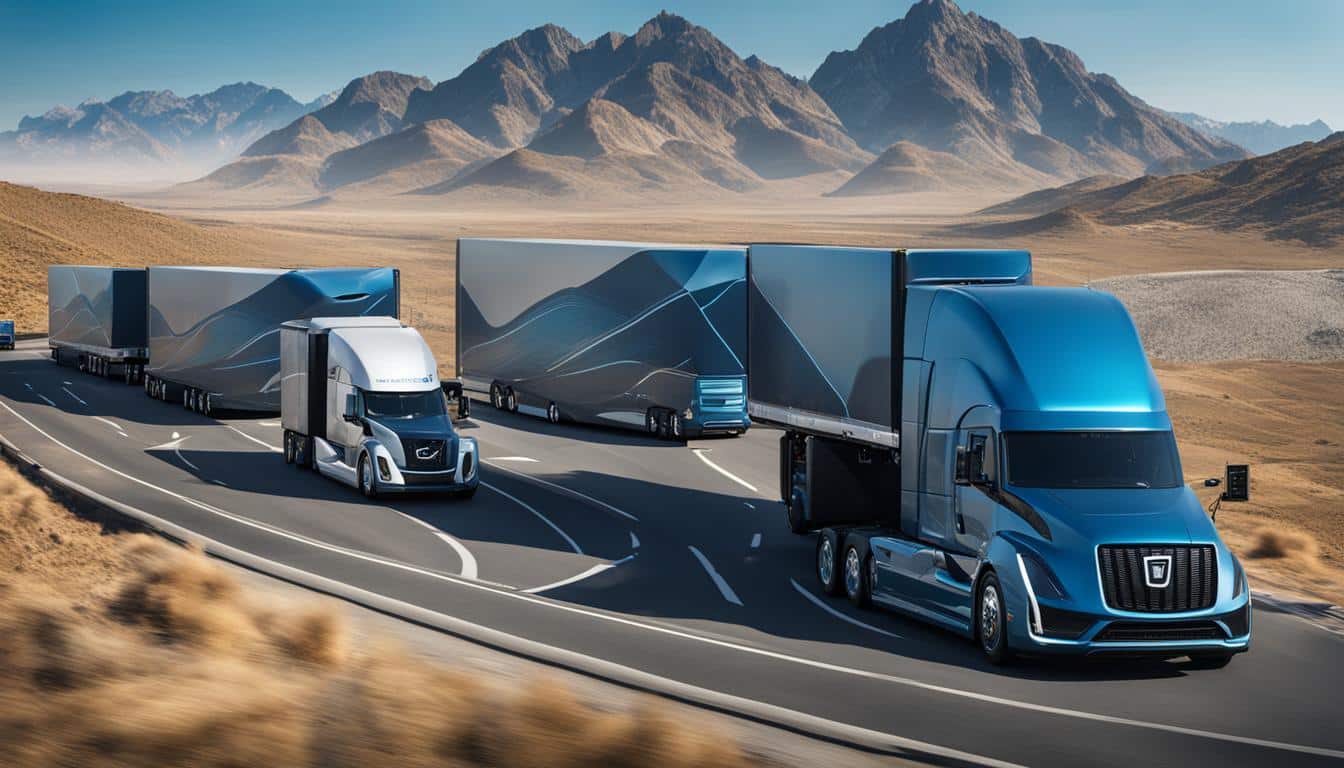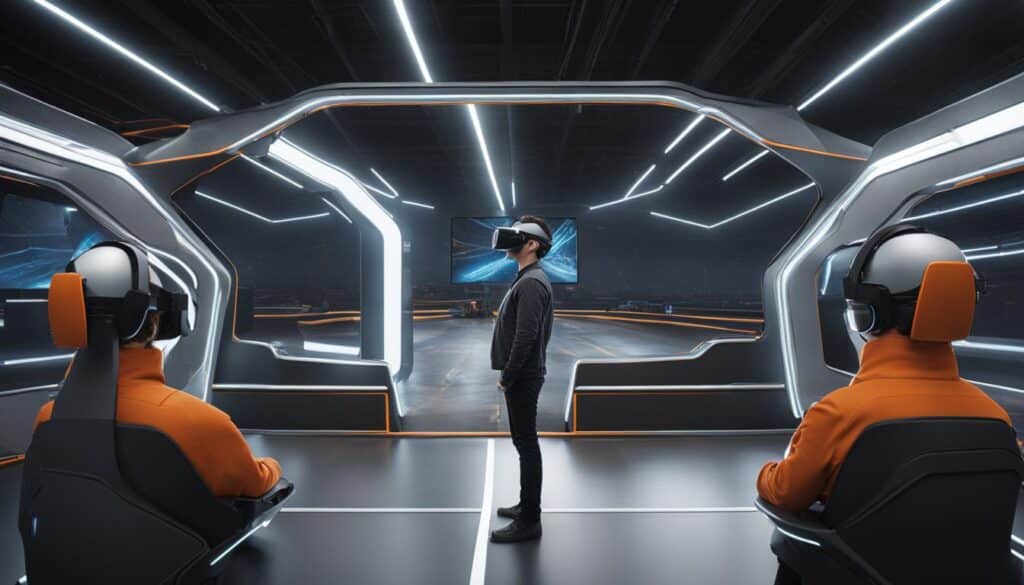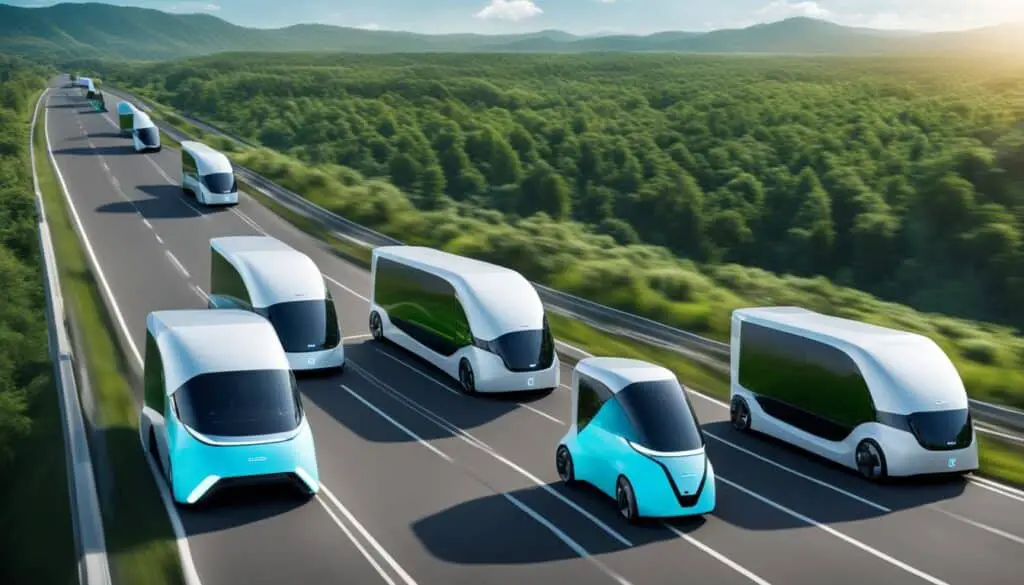
The Future of Trucking: Autonomous Logistics on the Rise
The realm of autonomous trucking and logistics has seen significant developments in recent years. From the integration of artificial intelligence (AI) and 5G technology in smartphones to the emergence of virtual reality (VR) and augmented reality (AR) experiences, the future of trucking is being revolutionized. Companies like Samsung, Huawei, Oculus, HTC, and Apple are at the forefront of these innovations, offering foldable smartphones, improved VR headsets, AR glasses, and more. Additionally, the growth of home automation, wearable tech for health and fitness, electric vehicles, and drone and robotics technology are reshaping the transport industry. These developments are paving the way for a more efficient, sustainable, and connected future in trucking and logistics.
Advancements in Smartphones and AI Technology
The smartphone industry is in a constant state of evolution, thanks to the pioneering efforts of major players like Apple, Samsung, Google, and OnePlus. These tech giants are pushing the boundaries with innovative features and cutting-edge technology.
One exciting trend in the smartphone market is the rise of foldable phones. These devices offer larger screens that can be conveniently folded into a pocketable form factor. With foldable phones, users can enjoy the best of both worlds – the portability of a smartphone and the immersive experience of a tablet. Foldable phones revolutionize the way we interact with our devices, providing a versatile and dynamic user experience.
Another significant advancement is the integration of 5G technology into smartphones. With 5G, users can experience remarkably faster download speeds, smoother streaming, and improved overall connectivity. This integration enables a more seamless and immersive smartphone experience, whether it’s browsing the web, streaming media, or playing online games.
Under-display cameras are another impressive development in smartphone technology. These cameras are discreetly hidden under the display, allowing for a more immersive and uninterrupted screen experience. By eliminating the need for a visible front-facing camera, manufacturers can maximize the screen-to-body ratio, resulting in a more immersive visual experience for users.
Furthermore, AI-powered photography features have transformed smartphone cameras into powerful tools for capturing stunning photos and videos. With enhanced image processing capabilities and advanced scene recognition algorithms, smartphones can intelligently optimize settings and produce professional-quality shots with ease. Whether it’s low-light photography, portrait mode, or AI-driven filters and effects, these AI-powered features enhance the overall photography experience, making it accessible to users of all skill levels.
The seamless integration of cutting-edge technology and AI capabilities is propelling smartphones to new heights, leading to more immersive experiences, faster connectivity, and unparalleled photography capabilities.
Immersive Experiences with VR and AR Technology
Virtual reality (VR) and augmented reality (AR) technologies are revolutionizing the way we experience entertainment, education, and more. With constant advancements from industry leaders such as Oculus, HTC, Sony, Apple, and Microsoft, VR headsets have significantly improved, providing users with higher resolution displays and more immersive experiences.
Not to be left behind, rumors are circulating about Apple and Microsoft working on AR smart glasses that will overlay digital information onto the real world. This exciting development opens up endless possibilities for mixed reality applications in various industries, including education, architecture, and entertainment.
Imagine being able to explore ancient historical sites up close in virtual reality or having holographic blueprints projected onto construction sites with AR glasses. Through the convergence of VR and AR, mixed reality is shaping a new era of interactive and immersive experiences.
In fact, let’s take a moment to dive deeper into the world of mixed reality applications with the following highlights and use cases:
Education:
- Virtual field trips, allowing students to visit historical landmarks, museums, and even outer space.
- Interactive simulations for science experiments, medical training, and engineering designs.
Architecture:
- Virtual walkthroughs of architectural designs, allowing clients to experience and make real-time changes.
- Augmented reality overlays for structural analysis, precise measurements, and planning.
Entertainment:
- Immersive virtual reality gaming experiences, transporting players to fantastical worlds.
- AR-enhanced live performances and shows, blending digital effects with real-life performances.
These are just a few examples of how improved VR headsets, AR smart glasses, and the innovative applications of mixed reality are revolutionizing industries across the board. The possibilities are endless, and as technology continues to evolve, our ability to create even more immersive and interactive experiences will only grow.
Virtual reality and augmented reality are not just about entertainment; they have the power to transform how we learn, work, and engage with the world around us. The future is filled with exciting opportunities for exploration, collaboration, and discovery through VR and AR technologies.
To further illustrate the potential of immersive experiences, take a look at this visually captivating image:

As you can see, the combination of VR and AR is taking us on a journey beyond what we once thought possible, blurring the lines between the digital and physical worlds. With improved VR headsets, AR smart glasses, and the ever-expanding world of mixed reality applications, we can look forward to even more transformative experiences in the future.
Revolutionizing Home Automation and Wearable Tech
As we embrace the era of smart technology, home automation and wearable tech have emerged as key players in enhancing our daily lives. From voice assistants to smart security systems, connected appliances to wearable health monitoring devices, these innovations are transforming the way we interact with our homes and monitor our well-being.
Voice Assistants: Redefining Convenience
Voice assistants like Amazon Echo and Google Home have become integral parts of many households, offering a seamless and hands-free way to control our environments. With improved natural language processing capabilities, these devices understand our commands and carry out tasks effortlessly. Whether it’s adjusting the thermostat, playing music, or even ordering groceries, voice assistants make everyday tasks more convenient.
Smart Security Systems: Keeping You Safe
Home security has reached new heights with the integration of AI-powered cameras and facial recognition technology. These advanced systems provide enhanced surveillance and real-time monitoring, ensuring the safety of our homes and loved ones. With features like motion detection, remote access, and custom alerts, smart security systems offer peace of mind and unparalleled protection.
Connected Appliances: Effortless Efficiency
From refrigerators to washing machines, our appliances have become smarter and more connected than ever before. With advanced sensors and internet connectivity, these appliances offer a range of benefits, such as optimized energy usage, remote control options, and personalized settings. Imagine checking your fridge’s inventory while at the grocery store or preheating your oven on the way home from work. Connected appliances bring convenience and efficiency to our daily routines.
Wearable Health Monitoring: Tracking Your Well-being
Wearable tech, including smartwatches and fitness trackers, has evolved beyond simply counting steps and measuring heart rate. These devices now offer comprehensive health monitoring capabilities, allowing us to track vital metrics like heart rate variability, blood pressure, and sleep quality. With the ability to set fitness goals, monitor progress, and receive personalized insights, wearable health monitoring devices empower us to prioritize our well-being and make informed lifestyle choices.
With the integration of voice assistants, smart security systems, connected appliances, and wearable health monitoring devices, our homes are becoming smarter and more efficient. These technologies bring convenience, safety, and improved well-being to our daily lives, revolutionizing the way we interact with our environments.
| Benefits of Home Automation and Wearable Tech | Voice Assistants | Smart Security Systems | Connected Appliances | Wearable Health Monitoring |
|---|---|---|---|---|
| Convenience | ✓ | |||
| Safety | ✓ | |||
| Efficiency | ✓ | |||
| Well-being | ✓ |
The Future of Trucking: Embracing Innovation and Sustainability
In order to thrive in the ever-evolving world of trucking and logistics, it is essential to embrace innovation and sustainability. The future of this industry is closely intertwined with key technological advancements that are poised to reshape the way goods are transported and delivered.
One significant development is the increasing expansion of electric vehicles by major automakers. These eco-friendly alternatives are making sustainable transportation more accessible and reducing carbon emissions. With advancements in battery technology and charging infrastructure, electric trucks are becoming a viable option for businesses looking to embrace a greener future.
Another game-changer in the industry is the rise of self-driving cars equipped with advanced driver-assistance systems (ADAS). These vehicles have the potential to enhance safety, increase efficiency, and revolutionize logistics operations. With autonomous vehicles, long-haul trucking can become more efficient and cost-effective, as the need for human drivers can be minimized or eliminated.
Delivery drones are also on the horizon, promising faster and more efficient last-mile delivery solutions. Companies like Amazon are investing heavily in drone technology, envisioning a future where packages are transported through the air, bypassing congested roads and reducing delivery times. This innovation has the potential to transform e-commerce and logistics, offering unprecedented speed and convenience.
Blockchain technology and cryptocurrency are also playing a role in shaping the future of trucking. The decentralized nature of blockchain has the potential to streamline supply chain processes, enhance transparency, and reduce fraud. Additionally, the exploration of central bank digital currencies (CBDCs) and the rise of decentralized finance (DeFi) platforms and non-fungible tokens (NFTs) are revolutionizing financial transactions within the industry.
Lastly, space exploration is emerging as a new frontier for the trucking and logistics industry. Companies like SpaceX and Blue Origin are paving the way for commercial space travel and missions to the Moon and Mars. This opens up possibilities for interplanetary logistics and the transportation of goods to space stations and future colonies.
By embracing these innovations and sustainable practices, the trucking and logistics industry can lead the way towards a more efficient, connected, and eco-friendly future. From electric vehicles to self-driving cars, delivery drones, blockchain and cryptocurrency, and space exploration, each advancement offers unique opportunities for growth and transformation.

| Advancements | Impacts |
|---|---|
| Electric Vehicles | – Reduced carbon emissions – Increased sustainability – Accessible transportation |
| Self-Driving Cars | – Enhanced safety – Improved efficiency – Automation of long-haul trucking |
| Delivery Drones | – Faster and more efficient last-mile delivery – Potential for transformative impact on e-commerce |
| Blockchain and Cryptocurrency | – Streamlined supply chain processes – Enhanced transparency and security |
| Space Exploration | – Commercial space travel – Interplanetary logistics |
Conclusion
The future of trucking and logistics holds immense potential for innovation and sustainability. With advancements in autonomous vehicles, AI-powered smartphones, VR/AR experiences, home automation, wearable tech, and space exploration, the industry is undergoing a transformative revolution. These developments are paving the way for a more efficient, connected, and eco-friendly future.
As the trucking and logistics industry embraces these technological changes, it becomes vital to adopt innovative practices and prioritize sustainability. Staying informed and proactively incorporating new technologies will be essential for companies to thrive in this evolving landscape. By doing so, the future of trucking and logistics can be characterized by increased efficiency, improved safety measures, and a conscious regard for the environment.
Adapting to autonomous logistics and leveraging innovative technologies will yield numerous benefits. Autonomous vehicles can optimize routes and reduce fuel consumption, resulting in cost savings and environmental conservation. AI-powered smartphones enable seamless communication, data management, and streamlined operations. VR/AR experiences enhance training programs and aid in remote assistance. Home automation and wearable tech can improve productivity and provide valuable insights for health and safety management. Lastly, space exploration opens up new avenues for future logistical challenges.
The future of trucking and logistics is an exciting time of groundbreaking possibilities. By capitalizing on innovative technology and prioritizing sustainability, companies can shape a future marked by increased efficiency, enhanced safety, and a greener planet. Embracing these advancements, staying ahead of industry trends, and incorporating sustainable practices will be the driving factors behind success in the ever-evolving world of trucking and logistics.
FAQ
What are the developments in autonomous trucking and logistics?
The realm of autonomous trucking and logistics has seen significant advancements in recent years. From the integration of artificial intelligence (AI) and 5G technology in smartphones to the emergence of virtual reality (VR) and augmented reality (AR) experiences, the future of trucking is being revolutionized. Companies like Samsung, Huawei, Oculus, HTC, and Apple are at the forefront of these innovations, offering foldable smartphones, improved VR headsets, AR glasses, and more. Additionally, the growth of home automation, wearable tech for health and fitness, electric vehicles, and drone and robotics technology are reshaping the transport industry. These developments are paving the way for a more efficient, sustainable, and connected future in trucking and logistics.
What are the advancements in smartphones and AI technology?
The smartphone industry continues to evolve rapidly, with companies like Apple, Samsung, Google, and OnePlus leading the way. Foldable phones are gaining popularity, offering larger screens in pocketable form factors. Integration of 5G technology in smartphones is also expanding, delivering faster download speeds and better connectivity. Under-display cameras are being perfected, providing users with uninterrupted screen experiences. AI-powered photography features, such as enhanced image processing and scene recognition, are revolutionizing smartphone cameras, allowing users to capture stunning photos and videos effortlessly.
How are VR and AR technology transforming the way we experience entertainment?
Virtual reality (VR) and augmented reality (AR) technologies are transforming the way we experience entertainment, education, and more. Companies like Oculus, HTC, Sony, Apple, and Microsoft are continuously improving VR headsets, offering higher resolution displays and more immersive experiences. AR smart glasses are rumored to be released by Apple and Microsoft, overlaying digital information onto the real world. The convergence of VR and AR, known as mixed reality, is giving rise to new applications in various industries, including education, architecture, and entertainment.
What are the advancements in home automation and wearable tech?
Home automation is becoming more prevalent, with devices like Amazon Echo and Google Home integrating into daily life, offering improved natural language processing and expanded functionality. Enhanced smart security systems with AI-powered cameras and facial recognition are making homes safer. Connected appliances, from refrigerators to washing machines, are becoming more sophisticated, providing convenience and efficiency. Wearable tech, such as smartwatches and fitness trackers, are advancing in health monitoring capabilities, tracking metrics like heart rate, blood pressure, and sleep patterns.
How is the future of trucking embracing innovation and sustainability?
The future of trucking is closely tied to key technological advancements. The expansion of electric vehicle models by major automakers is making sustainable transportation more accessible. Self-driving cars equipped with advanced driver-assistance systems (ADAS) are improving safety and convenience on the roads. Delivery drones are being developed by companies like Amazon, potentially transforming e-commerce and logistics. Blockchain technology is shaping the future of finance, with the exploration of central bank digital currencies (CBDCs) and the rise of decentralized finance (DeFi) platforms and non-fungible tokens (NFTs). Space exploration is also on the horizon, with companies like SpaceX and Blue Origin working towards enabling commercial space travel and missions to the Moon and Mars. Embracing these innovations and sustainable practices can lead to a more efficient, connected, and eco-friendly future in the trucking and logistics industry.
Source Links
- https://medium.com/@writeswhilewalks/unveiling-the-future-a-comprehensive-guide-to-2024s-hottest-tech-gadgets-ff8b1a47b466
- https://www.planetizen.com/features/126996-paris-great-heres-where-green-mobility-revolution-happening
- https://sg.finance.yahoo.com/news/djis-first-delivery-drone-takes-130000015.html
